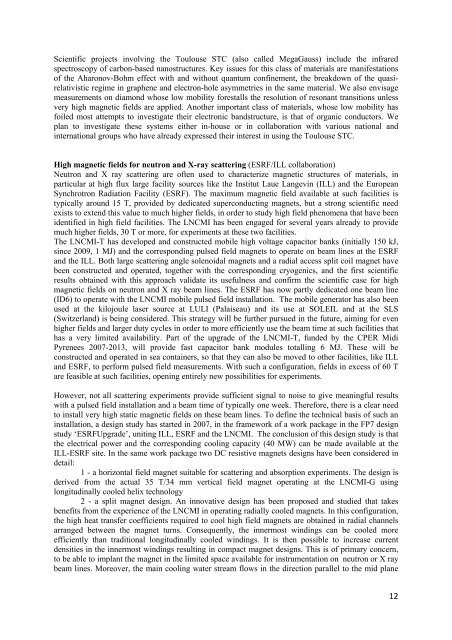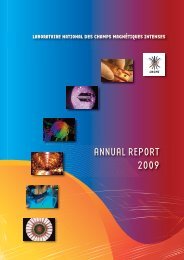Laboratoire National des Champs Magnétiques Pulsés CNRS – INSA
Laboratoire National des Champs Magnétiques Pulsés CNRS – INSA
Laboratoire National des Champs Magnétiques Pulsés CNRS – INSA
You also want an ePaper? Increase the reach of your titles
YUMPU automatically turns print PDFs into web optimized ePapers that Google loves.
Scientific projects involving the Toulouse STC (also called MegaGauss) include the infrared<br />
spectroscopy of carbon-based nanostructures. Key issues for this class of materials are manifestations<br />
of the Aharonov-Bohm effect with and without quantum confinement, the breakdown of the quasirelativistic<br />
regime in graphene and electron-hole asymmetries in the same material. We also envisage<br />
measurements on diamond whose low mobility forestalls the resolution of resonant transitions unless<br />
very high magnetic fields are applied. Another important class of materials, whose low mobility has<br />
foiled most attempts to investigate their electronic bandstructure, is that of organic conductors. We<br />
plan to investigate these systems either in-house or in collaboration with various national and<br />
international groups who have already expressed their interest in using the Toulouse STC.<br />
High magnetic fields for neutron and X-ray scattering (ESRF/ILL collaboration)<br />
Neutron and X ray scattering are often used to characterize magnetic structures of materials, in<br />
particular at high flux large facility sources like the Institut Laue Langevin (ILL) and the European<br />
Synchrotron Radiation Facility (ESRF). The maximum magnetic field available at such facilities is<br />
typically around 15 T, provided by dedicated superconducting magnets, but a strong scientific need<br />
exists to extend this value to much higher fields, in order to study high field phenomena that have been<br />
identified in high field facilities. The LNCMI has been engaged for several years already to provide<br />
much higher fields, 30 T or more, for experiments at these two facilities.<br />
The LNCMI-T has developed and constructed mobile high voltage capacitor banks (initially 150 kJ,<br />
since 2009, 1 MJ) and the corresponding pulsed field magnets to operate on beam lines at the ESRF<br />
and the ILL. Both large scattering angle solenoidal magnets and a radial access split coil magnet have<br />
been constructed and operated, together with the corresponding cryogenics, and the first scientific<br />
results obtained with this approach validate its usefulness and confirm the scientific case for high<br />
magnetic fields on neutron and X ray beam lines. The ESRF has now partly dedicated one beam line<br />
(ID6) to operate with the LNCMI mobile pulsed field installation. The mobile generator has also been<br />
used at the kilojoule laser source at LULI (Palaiseau) and its use at SOLEIL and at the SLS<br />
(Switzerland) is being considered. This strategy will be further pursued in the future, aiming for even<br />
higher fields and larger duty cycles in order to more efficiently use the beam time at such facilities that<br />
has a very limited availability. Part of the upgrade of the LNCMI-T, funded by the CPER Midi<br />
Pyrenees 2007-2013, will provide fast capacitor bank modules totalling 6 MJ. These will be<br />
constructed and operated in sea containers, so that they can also be moved to other facilities, like ILL<br />
and ESRF, to perform pulsed field measurements. With such a configuration, fields in excess of 60 T<br />
are feasible at such facilities, opening entirely new possibilities for experiments.<br />
However, not all scattering experiments provide sufficient signal to noise to give meaningful results<br />
with a pulsed field installation and a beam time of typically one week. Therefore, there is a clear need<br />
to install very high static magnetic fields on these beam lines. To define the technical basis of such an<br />
installation, a <strong>des</strong>ign study has started in 2007, in the framework of a work package in the FP7 <strong>des</strong>ign<br />
study ‘ESRFUpgrade’, uniting ILL, ESRF and the LNCMI. The conclusion of this <strong>des</strong>ign study is that<br />
the electrical power and the corresponding cooling capacity (40 MW) can be made available at the<br />
ILL-ESRF site. In the same work package two DC resistive magnets <strong>des</strong>igns have been considered in<br />
detail:<br />
1 - a horizontal field magnet suitable for scattering and absorption experiments. The <strong>des</strong>ign is<br />
derived from the actual 35 T/34 mm vertical field magnet operating at the LNCMI-G using<br />
longitudinally cooled helix technology<br />
2 - a split magnet <strong>des</strong>ign. An innovative <strong>des</strong>ign has been proposed and studied that takes<br />
benefits from the experience of the LNCMI in operating radially cooled magnets. In this configuration,<br />
the high heat transfer coefficients required to cool high field magnets are obtained in radial channels<br />
arranged between the magnet turns. Consequently, the innermost windings can be cooled more<br />
efficiently than traditional longitudinally cooled windings. It is then possible to increase current<br />
densities in the innermost windings resulting in compact magnet <strong>des</strong>igns. This is of primary concern,<br />
to be able to implant the magnet in the limited space available for instrumentation on neutron or X ray<br />
beam lines. Moreover, the main cooling water stream flows in the direction parallel to the mid plane<br />
12







